
There are three ways to launch a glider: aerotow, ground-tow (auto or winch) and self-launch. Since August 4, 1997, flight instructors are required to enter endorsements in pilot's log books to indicate the type(s) of launch they have trained the pilot to perform. Self launching techniques vary with the motorglider make and model. The information presented here applies to aerotow and ground-tow.
Regulations require that a person flying an aircraft towing a glider has logged at least 100 hours of pilot-in-command time in the aircraft category, class, and type, of aircraft used to tow a glider. In addition, the tow pilot, within the preceding 12 months, must have made at least three actual or simulated glider tows while accompanied by a qualified pilot who meets the requirements of this section; or made at least three flights as pilot in command of a glider towed by an aircraft.
Also, the towline used must have a breaking strength not less than 80 percent of the maximum gross weight of the glider and not more than twice this weight. However, the towline used may have a breaking strength more than twice the maximum gross weight of the glider if a safety link is installed at the glider with a breaking strength not less than 80 percent and not greater than twice this weight and a safety link is installed at the towing aircraft with a breaking strength greater, but not more than 25 percent greater, than that of the safety link at the towed glider end of the towline and not greater than twice the glider maximum gross weight. Although not an acceptable substitute for a weak link, "An ordinary square knot cuts rope strength in half." (10)
The pre-takeoff check is an essential safety action prior to flight. Many gliders have the check list displayed on the panel and if they do the pilot should utilize it to preclude memory errors. A memory aid in case there is no placard is ABCCCD, which reminds the pilot:
When the glider and tow plane are positioned to begin the launch procedure, the wing runner will assist in attaching the tow line to the glider. If the glider has both nose hitch and CG (center of gravity) hitch, the nose hitch should be used for aero tow.
The wing runner may signal the glider pilot to open and close the release by a simple hand signal that simulates opening and closing with the thumb and forefinger. However, the close proximity of the participants makes verbal signals equally effective.
 | When ready to start the aerotow takeoff sequence, the glider pilot signals the wing runner by a thumbs up signal. The wing runner then raises the glider wing and signals the tow pilot to take up slack in the line by moving his/her arm back and forth. |
 | The official hold signal for aerotow operations is to raise both hands above the head. If the wing runner is holding the wing tip up with one hand to signal "take up slack", lifting the other hand above the head is also used to indicate "hold" when the slack is gone. The new FAA publication, "Glider Flying Handbook"(18), shows the signal for "hold" to be "arms straight out and held steady", but the current knowledge tests use the signal shown here. |
 | Moving the hand across the neck in a cutting motion is the signal to release the tow line. |  | Waving the hands back and forth above the head is the "stop operation emergency" signal. |
 | The tow pilot signals ready for takeoff by waggling the rudder. (Waggling the rudder, both on the ground and in the air, is also used by the tow pilot to signal a problem with the glider, such as dive brakes open). To begin aerotow takeoff, the glider pilot waggles the glider rudder. The wing runner relays this signal to the tow pilot by a circular motion of the arm. |
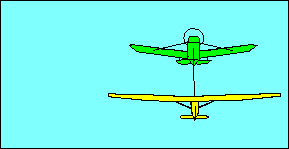 | When airborne on aerotow the glider pilot can steer the tow pilot by moving to one side. This pulls the tow plane tail to the same side and points the tow plane in the opposite direction, i.e. the desired direction of turn. In our illustration the glider is moved laterally by lowering the wing, although lateral movement by rudder is acceptable. In either case, the glider assumes the appropriate bank angle once the tow plane starts to turn. |
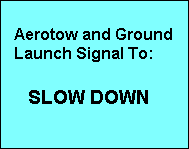 | Signals to speed up or slow down can be used with both aerotow and ground launch. Yawing the glider back and forth (fishtailing) signals slow down and rocking the glider wings signals speed up. On aerotow, both these signals are given with the glider directly behind the tow plane. |
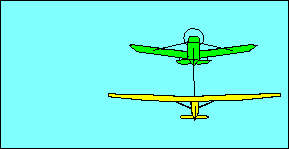 | The aerotow signal that the glider cannot release is also rocking the wings. It differs from the "speed up" signal by first moving out to one side where the glider is clearly visible to the tow pilot. For a tow plane with side-by-side seating, this would be the left side. The tow pilot would normally proceed to a place where the glider could continue the flight safely and the tow line would not create a hazard for anyone on the ground before releasing the line from the tow plane end. |
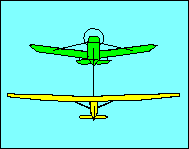 | In the unlikely event that the tow pilot also cannot release, the signal is for the tow plane to yaw back and forth (fishtail). An acceptable procedure to follow in this case is for the aircraft to return for landing still connected by the tow line. The glider should descend to the low tow position and touch down first, but be careful not to brake until the tow plane is also safely on the ground. Some instructors recommend instead, to break the tow line. |
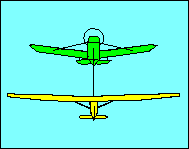 | Glider pilots should always be alert for a "wave off" signal from the tow plane. It is given by rocking the tow plane’s wings, and signals that the tow pilot has a problem that precludes continuing the flight with the glider in tow. Immediate release is mandatory, regardless of the inconvenience to the glider pilot. To be certain that the glider pilot can distinguish between a wave off and normal turbulence, the maneuver should be demonstrated thoroughly during training. |
Takeoff is a relatively simple maneuver but it has the potential for serious errors. Since air rushing into the base of thermals often results in wind direction differences from one end of the runway to the other, glider pilots always should be prepared for a crosswind at any point during takeoff. Crosswind corrections should be applied, removed or modified as necessary during all takeoffs.
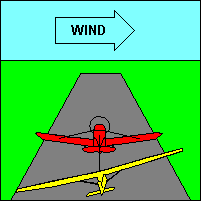
| For aerotow takeoff it is convenient to divide the takeoff into three segments. While both aircraft are rolling, the upwind wing should be held low. It is much easier to relax this correction when it is too much than to increase it when it is too little, so starting with more aileron than you think you need is appropriate. Also anticipating the weathervaning tendency by applying downwind rudder before starting the takeoff roll is good practice. Once rolling, the rudder is used to maintain position behind the towplane. With the glider in the air but the towplane still rolling, it is customary to maintain position behind the towplane by crabbing. Advocates of the crab method rather than the wing low method point out the reduced risk of touching a wing tip to the ground and that crabbing usually results in less drag than slipping. It is important to keep the glider low during this segment to avoid lifting the tail of the towplane with potentially disastrous consequences. Once the towplane lifts off the glider can assume a normal tow position relative to the towplane unless obstructions dictate otherwise. |
Glider pilot Practical Test Standards AREA IV, TASK C, MAINTAINING TOW POSITIONS, requires pilots to exhibit knowledge of and demonstrate skill in both high-tow (slightly above the wake) and low-tow (slightly below the wake). "HIGH TOW ... permits better visibility for both pilots and provides the added safety feature of an immediate release by either aircraft without a danger of the tow rope becoming entangled on the sailplane." (7)
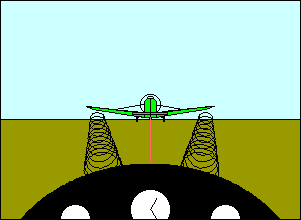 | Visual references needed to maintain vertical position in each case must be developed by the pilot. For high-tow, placing the tow plane on the horizon will result in the glider being slightly above the wake because anything on the horizon is at eye level, and the tow plane wake descends slightly below its flight path, so it will be below the glider some 200 feet behind the tow plane. The pilot can find the low-tow position by descending slowly through the wake until its effects can no longer be detected. For most tow planes, that will place the glider where the bottom surface of the tow plane's horizontal tail surfaces are clearly visible and the bottom surface of its wing will be barely visible. |
Straight flight in either high-tow or low-tow requires that the pilot maintain lateral position behind the tow plane. This is easily accomplished by keeping the glider wings level and its nose pointed at the tow plane tail. Turning on tow requires some additional effort and can produce some interesting experiences if not done correctly. It is one of the top ten reasons for failing a practical test.
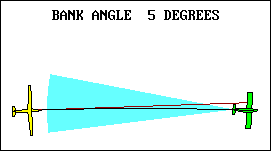 | Many flight instructors advise students to match the tow plane bank angle and point the nose of the glider at the tow plane's outer wing tip. This works well for modest bank angles, but not for those greater than about 15 degrees. The accompanying illustration is based on a Pawnee towing a Schweizer SGS 2-33 at 65 MPH with a 200 foot line, but it is probably representative of most other towing operations. The black line represents the desired flight path of both aircraft. The red line corresponds to the glider longitudinal axis and thus shows the direction that the glider is pointed. The arc in which both sides of the tow plane fuselage are visible is shown in light blue. |
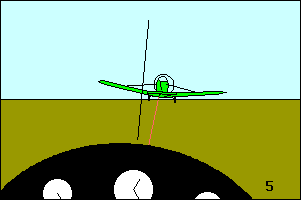 | Here is the view from inside the glider for bank angles from 5 to 35 degrees. The black line perpendicular to the glider bank angle indicates the direction its nose is pointed. Again note that it is necessary to point the glider outside the tow plane left wing tip as the bank angle increases beyond about 15 degrees, and we lose sight of the left side of the tow plane fuselage about the same time. |
In our illustrations we show the desired flight path of both aircraft to be the same. That is desirable because of the relationship between turn radius, speed and bank angle (Turn Radius (ft) = True Airspeed (kts) Squared, Divided by 11.26, Divided by the Tangent of the Bank Angle). If the glider is turning at a radius greater than the tow plane it must also be flying at a higher speed in order to complete each circle in the same time. (Increased airspeed also produces a tendency to climb.) Because its turn radius is a function of its speed squared the bank angle must be greater than that of the tow plane to compensate for the effect of higher speed. The reverse is true if the glider is flying inside the tow plane's flight path. Therefore, the only way that both aircraft can be flying coordinated at the same bank angle is if they are also flying at the same speed and on the same turn radius. Minor deviations from this ideal can be tolerated but they necessarily imply some rudder use that results in less than perfect coordination. It is generally true that it is better for the glider to be in the correct tow position than to be coordinated, but if the yaw string is not centered during aerotow, the pilot's technique is less than perfect.
"When the towplane and glider bank into a turn simultaneously, the glider will turn slightly inside the towplane. Some instructors prefer a more elegant style, and teach the student to delay banking two or three seconds.. This technique, ..tends to keep the glider turning on the perimeter of the same circle as the towplane. If the turn is begun too soon, or at a bank angle greater than the towplane's, the towplane's nose is pulled to the outside of the turn. If the glider does move out to one side of the towplane, the glider pilot has to decide whether he is holding a wing down, pushing on a rudder pedal without realizing it, or both." (12)
If the glider is inside the tow plane's flight path, correction is easy. The glider bank angle should be reduced until it returns to the correct position. Since the glider is flying at a lower airspeed than the tow plane it will accelerate as its turn radius increases so there will be no tendency for slack to develop in the tow line.
If the glider is outside the tow plane's flight path (i.e. flying on a larger turn radius) correction is more difficult and must be initiated immediately. If not, the glider will tend to move even farther out because of the relationship between speed, bank and turn radius.
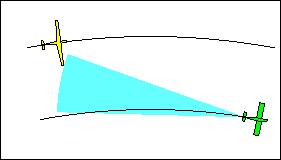 | The correction involves increasing the glider bank angle enough to decrease its turn radius. In this case the glider is flying faster than the tow plane so it will tend to overtake the tow plane as the glider turn radius decreases unless the glider pilot takes action to reduce the glider's airspeed. Failure to take preventive action will result in slack in the tow line. (It is always better to prevent slack than to take it out.) The best way to do this is to yaw the glider away from the tow plane, creating enough drag to slow the glider and prevent slack from developing in the line. This is essentially a slip, and it can be used to prevent slack in other situations such as recovery from an excessively high tow position. |
Despite the pilot's best intentions, slack may still occur in the tow line. ("The primary cause of slack line is acceleration." (7).) Skill in removing slack must be developed to handle these situations, and it must be demonstrated on all pilot practical tests. Slack is the result of the glider flying faster than the tow plane. As we have just seen, that can occur when the glider gets outside in a turn. It can also be caused by turbulence, but regardless of the cause, it must be corrected promptly. Since the slack was caused by the glider flying faster than the tow plane, it must be corrected by the glider flying slower, and when the correction is complete, both aircraft must again be flying at the same speed.
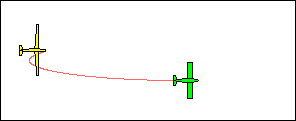 | One way to slow the glider is to create additional drag, and yawing it is a simple and easy way to do that. The pilot should yaw the glider's nose away from the tow plane so that it and the tow line are clearly visible during slack line recovery. This action tends to cause the glider to move away from the tow plane in the direction of the yaw, and it may be necessary to compensate by lowering the opposite glider wing. This is another case where the pilot can assign specific functions to each of the controls, recognizing, of course, that they still interact. |
Boxing the wake has no apparent practical use except as a training tool. It does allow the pilot to demonstrate the skill needed to maneuver the glider relative to the tow plane, and it is a required task on pilot practical tests.
 | By the time the wake reaches the glider in tow, the disturbed air is somewhat below the tow plane's flight path and about as wide as the tow plane's wing span. Boxing the wake is simply maneuvering the glider in a vertical rectangular path around the disturbed air. The direction is optional, but the tow pilot will prefer that the box be made clockwise. That way the rising side of the box will occur on the left, where the increased load due to climbing will help offset the left turning tendency of the tow plane. |
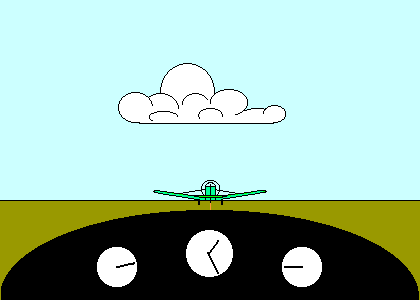 |
We begin the boxing maneuver with the glider in the high tow position
in straight flight.
The tow plane will appear on the horizon when viewed from the glider
because they are at the same height. Both aircraft wings are level. It is customary for the glider pilot to signal the tow pilot prior to boxing the wake by dropping down into low tow position by applying a slight increase in forward stick pressure. Then either box from there or return to the high tow position for boxing. Moving into low tow allows the glider pilot to review the visual clues that indicate that the glider is below the wake. For most tow planes the bottom side of the horizontal tail surfaces will be clearly visible and the bottom side of the wing will be barely visible. |
Transition between high and low tow directly behind the tow plane
exposes the glider to balanced vortices from both tow plane wing tips.
Although not part of "boxing the wake", it is beneficial for students
to explore the vortices separately by moving laterally while in the
wake. Unless a student has some practice dealing with the rolling
motion produced by a single vortex, inadvertent entry into one can be
an unpleasant experience.
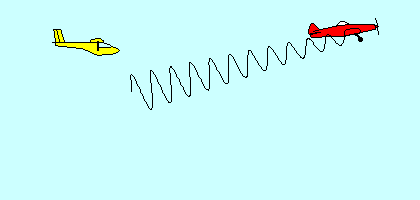 | An observant pilot may notice that the wake appears to be higher, relative to the tow plane, when the glider is moving up compared with its position when descending through the wake. This phenomenon is the result of the difference in load on the tow plane imposed by the glider when it is ascending versus when it is descending. The climb path of the tow plane is shallower when the glider is climbing and steeper when it is descending. |
Lateral movement on tow, necessary to box the wake, can be accomplished through use of either aileron or rudder or some combination of the two. It is probably easier to keep the glider wings level and move laterally with rudder alone. A more elegant method is to lower the wing slightly in the direction the pilot wants to move and keep the glider and tow plane longitudinal axes parallel with rudder. An additional benefit of this method is that it is consistent with other uses of aileron to effect lateral movement, both on tow and elsewhere, such as during a side slip. In our example here you will note that we use aileron for lateral movement and keep the glider longitudinal axis parallel to that of the tow plane.
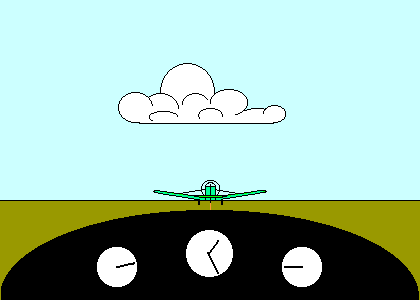 | It is again important to develop visual references to determine when the glider has moved out enough to clear the wake before it descends to the low tow position. A method that works well with most tail wheel tow planes is to observe the apparent motion of the tail wheel relative to the main gear of the tow plane. When the glider is directly behind the tow plane the tail wheel is centered between the main gear wheels. As the glider moves laterally, the tail wheel appears to move toward the opposite main gear wheel. When it has moved just outside that wheel the glider will be in position to clear the wake as it descends. |
The load imposed on the tow plane by the glider is the sum of the conventional drag from pulling the glider through the air and the force necessary to pull the glider up a slope equal to its climb angle. When the glider climbs or descends relative to the tow plane it is modifying this slope and thus the load on the tow plane.
 | When the climb or descent is to one side, as when boxing the wake, the change in load is reflected in a change in lateral force due to the angle between the tow line and the glider longitudinal axis. If the pilot fails to make necessary adjustments with the aileron and rudder, the glider will move farther out when descending and move farther in during ascent. The result will be a trapezoidal path around the wake rather than the desired rectangular path. |
When the glider pilot decides that it is time to release, he/she should clear the area in both directions, since both aircraft will be turning. The release should be made from the high tow position with normal tension on the towline. The tow pilot then can feel the release and prepare for descent. Release from low tow is possible but usually is not recommended. As soon as positive release is confirmed, the glider pilot should initiate a right turn (the tow pilot will turn left). Whether the glider turn should be a climbing turn or level turn is a subject of some controversy. In either case, the fact that the towing speed is likely higher than the speed the glider pilot elects to use, allows the glider pilot to convert the excess energy into altitude or a longer time before the glider starts to descend.
 | For ground launch, the signal to take up slack is for the wing runner to raise and lower the glider wing. When the slack has been removed, the wing tip is placed on the ground to signal "hold". |  | For ground launch operations, the signal to begin the takeoff is to level the glider wings. |
The number of variables inherent in ground launch (auto versus winch, location of tow hitch and launch vehicle power for examples) may result in variations in the takeoff procedure from site to site. A glider CG hitch is preferred for ground launch because it permits a higher altitude gain for a given line length, and it also reduces the pitch-up tendency that occurs if the line breaks. For auto tow with a crosswind, the towline should be laid out downwind from the car.
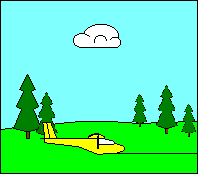 | Airspeed control is critical during ground launch to prevent overstressing the glider. In most flight conditions the pilot feels the same "g" forces that the aircraft is experiencing, thus providing a warning of impending overload. That is not true in ground launch since the pilot cannot sense the load imposed by the towline. It is therefore necessary to avoid exceeding the speed limitation for ground launch to preclude overstressing the glider. Increasing the climb angle usually increases the glider speed relative to the launch vehicle and lowering the nose reduces speed, just the opposite of normal flight. However, if the launch vehicle power is too low, increasing pitch may not increase airspeed. A general rule is to limit pitch attitude to 15 degrees at 50 feet, 30 degrees at 100 feet and 45 degrees at 200 feet. |
In any case, the auto tow vehicle speed should be determined prior to launch to minimize the risk of excess glider speed. The starting point is the glider's placard maximum ground launch speed. "Soaring Flight Manual"(7) says, From that, subtract the surface wind and an additional five miles per hour safety factor to obtain the initial launch speed. When the glider is 100-200 feet above the ground this speed should be further reduced ten miles per hour to allow for the glider speed increase due to the climb angle, and the surface wind speed again to account for any wind gradient. "Glider Flying Handbook"(18) agrees except that it recommends the adjustment for speed increase due to climb to be five miles per hour instead of ten. Both answers appear in the choices for at least one knowledge test question, so take your pick.
Emergency procedures during takeoff, such as towline break or launch vehicle problems, require action similar to those during aerotow with the added requirement of making an immediate pitch adjustment since the glider is in an extremely nose high attitude. Overrunning the towline at the beginning of the launch calls for immediate release. Porpoising, caused by stalling of the horizontal tail surface, can be corrected by reducing back pressure and resuming a shallower climb angle. Towline release failure may be solved by flying over the launch vehicle to allow the automatic release feature to function. If that fails, circling over the launch vehicle until the ground crew can cut the line is appropriate. Some instructors recommend circling in any case. Pilots always should follow site specific procedures.
© 2005 Jim D. Burch 602-942-2734 jdburch@att.net
To return to table of contents select TOC